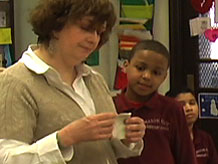What happens to weight and volume when we reshape a ball of clay?
1. Ask the question

Recall the last investigation, when students crushed a handful of shells in a bag.
- What did we discover about the weight of the crushed shells?
- It was the same as the weight of the whole shells.
- What about the volume?
- It was also the same.
Now pass around the four balls of plastic modeling clay.
- What do you know about this material? What are some of its properties? How is it different from shell?
- soft vs. hard, squishy vs. breakable, man-made vs. natural, different colors, etc.
Brittle vs. malleable: The terms brittle and malleable may be new to some students. While they may be familiar with materials that are brittle (glass, pottery, chalk) or malleable (clay, plastic modeling clay), they may not be aware that these are properties of the material.
Plastic modeling clay is a lot like clay, a natural earth material. Unlike shell, which is brittle, plastic modeling clay and clay are malleable; they can be reshaped without snapping into tiny pieces.
- But what happens when we change the shape of the plastic modeling clay? If we squish the ball really tight, does it get heavier? If we roll it out really thin, does it have more volume — or less?
- If one of you makes a dog out of the plastic modeling clay and another makes a snake, which will weigh more? Which will have more volume?
- What if you break the ball into 25 little pieces? Will there be more volume or less? What about the weight?
Listen to all the suggestions, and let students argue if they have different ideas, but make no judgments. Instead, introduce the investigation question:
What happens to weight and volume when we reshape of a ball of clay?
Explain that this investigation is much like the last one. Students will each take a ball of plastic modeling clay, measure its weight and volume, change its shape, and measure again. But instead of crushing the material, as they did with the shells, they can change it into any shape they please.



